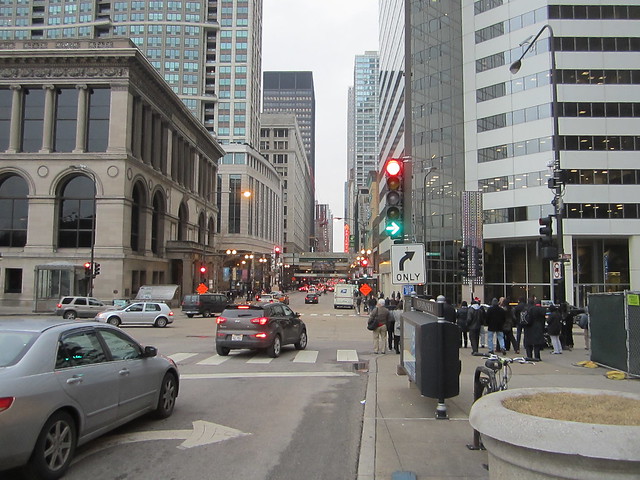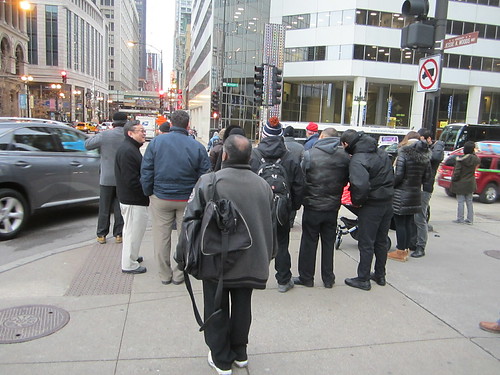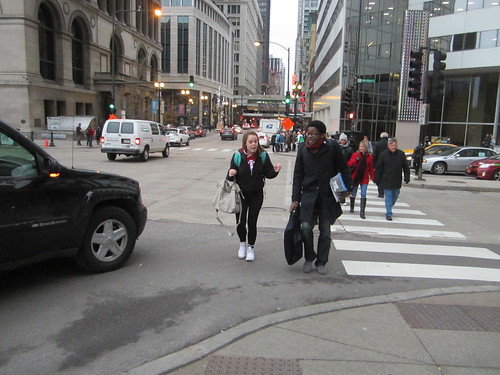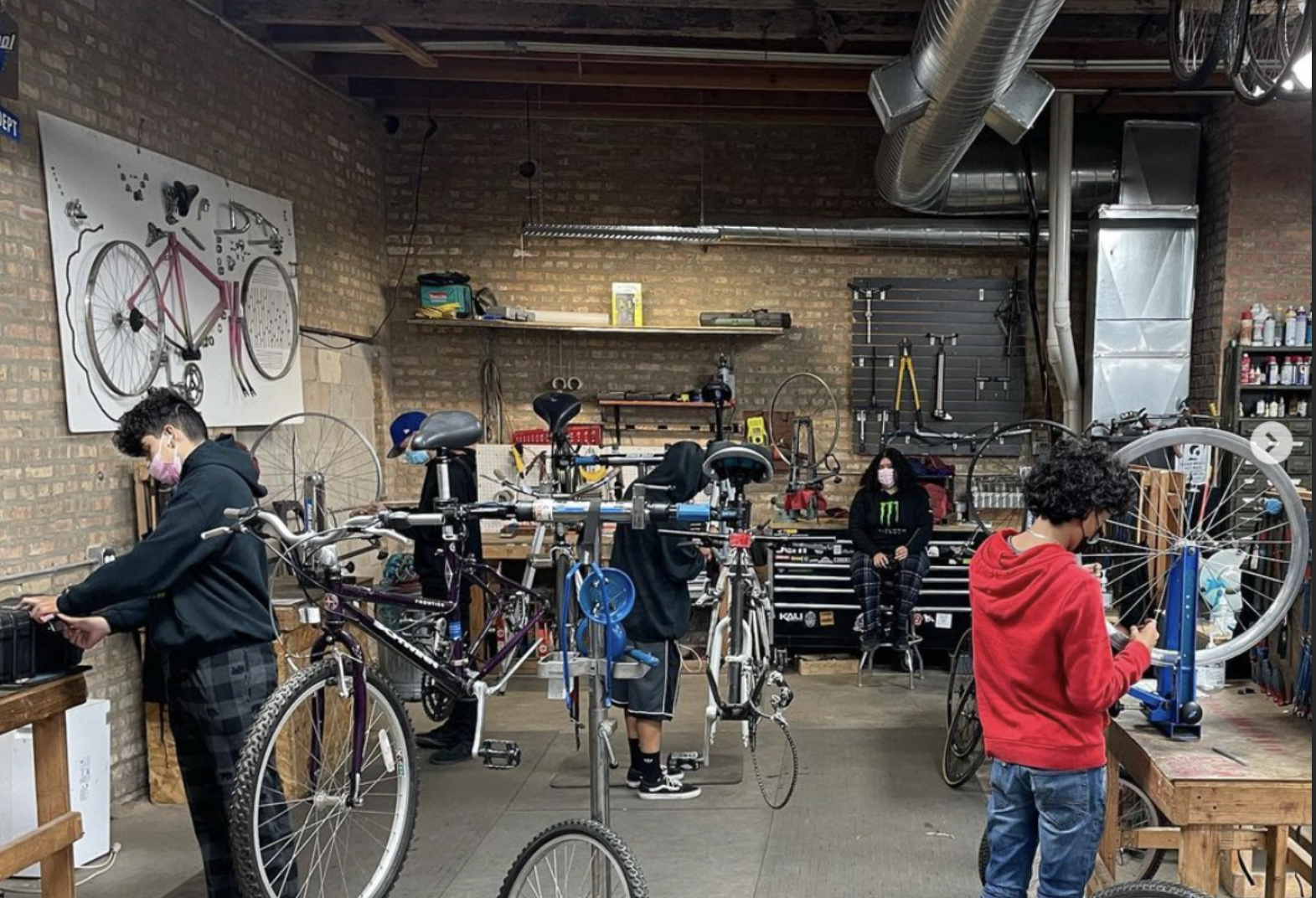CDOT Tweaks Randolph/Michigan, But It’s Still Dysfunctional for Pedestrians
6:31 PM CST on December 10, 2014
When you build a fabulous new attraction in the center of a bustling metropolis, you obviously want to maximize pedestrian access to make it easy for large numbers of people to walk there, right? That’s not what happened with Millennium Park.
A month after the music and art venue opened in the summer of 2004, drawing big crowds of pedestrians, the city actually took steps that made it more difficult to access the park on foot. After observing many conflicts between pedestrians crossing Michigan and motorists turning left onto the avenue, city traffic engineers solved the problem – by eliminating the pedestrians.
The Chicago Department of Transportation ground out crosswalks and barricaded corners at several intersections. Most egregiously, they removed the crosswalk at the south leg of Michigan/Randolph. At the time, a CDOT spokesman told me it was done because of safety concerns. Conveniently for motorists, however, eliminating this pedestrian movement also facilitated southbound turns onto Michigan by drivers heading west on Randolph.
The city spent $51,000 to install bollards and chains at the southwest and southeast corners of this intersection, deterring people from walking directly from the Chicago Cultural Center (which houses the city's main visitor info center) to Millennium Park. Instead, pedestrians are now expected to cross the street three times to make the same move: north across Randolph, east across Michigan, then south across Randolph again. In addition to creating a major detour across 19 lanes of traffic, this made the remaining crosswalks more crowded.
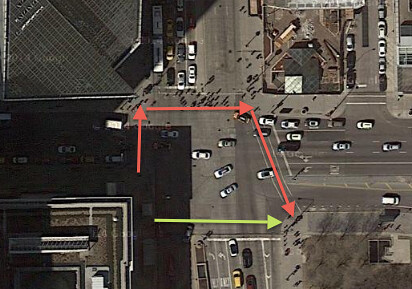
When the Emanuel administration took over in 2011, the appointment of forward-thinking transportation commissioner Gabe Klein suggested that this kind of cars-first planning might be a thing of the past. Shortly after he started at CDOT, I asked Klein if for his take on the Michigan Avenue situation, and the fact that the city had also taken out the midblock crosswalk between Buckingham Fountain and the lakefront in 2004.
“The Randolph/Michigan issue is interesting,” he said. “I don’t like it, from the standpoint that I would like to give priority to the pedestrians that we’re relying on to populate the park. Having said that, if the crosswalk was taken out because of safety concerns, then we really have to look at Michigan Avenue, which I think is just a problem.”
Klein added that he would like to reinstall the Buckingham crosswalk, and a few months later, CDOT did just that. Last summer, the department restriped the crossing at the north leg of Washington/Michigan, the main entrance to the park.
However, the Randolph/Michigan intersection has remained unchanged – until this fall. In October, CDOT installed a new right-turn arrow signal for drivers heading west on Randolph and turning north on Michigan. A recent newsletter from 42nd Ward Alderman Brendan Reilly, who bankrolled the project with ward money, claimed the new dedicated right-turn phase is reducing congestion.
“The busy intersection of Randolph Street and Michigan Avenue handles 45,000 cars every day, with residents, visitors, and tourists traveling between home, work, downtown institutions, and popular tourist destinations,” the newsletter noted. It didn’t mention how many pedestrians use the intersection, but judging from the throngs in the crosswalks, it’s likely that more people walk here than drive.
According to CDOT spokesman Pete Scales, the new right-turn phase does not negatively impact pedestrian crossing times for the north leg of the intersection. “In fact, we increased the ‘Walk’ time for crossing Michigan by two seconds for the period from 6 a.m. to 7 p.m., from Monday to Friday,” he said. “The two seconds were taken from the ‘Walk’ time for crossing Randolph.” Westbound drivers on Randolph were already allowed to turn right on red before the signal was installed.
With this new configuration, the dedicated right-turn phase comes up during the northbound and southbound left-turn phase on Michigan. Scales argued that the turn arrow reduces the number of right-turning vehicles waiting when westbound traffic gets the green, and pedestrians get a walk signal across Michigan. “By providing the right-turn arrow, the pedestrian and vehicular conflict is reduced -- thus improving pedestrian safety and traffic flow.”
That did seem to be the case when I stopped by this afternoon – by the time pedestrians got the go-ahead to cross, there weren’t many right-turning motorists left on Randolph. Those who remained after the walk signal came on generally did a good job of waiting for a break in foot traffic before attempting to turn. It appears the new signal has not made things worse for people on foot, and has perhaps improved things a bit.
However, the configuration of the intersection is still ridiculously slanted towards the convenience of motorists, because it requires many pedestrians to make three crossings where they should only need to make one. CDOT needs to reinstall the crosswalk on the south leg of the intersection. If they’re genuinely concerned about turning drivers endangering people on foot there, they should only allow turns during dedicated turn phases.
CDOT plans to release 2014 pedestrian counts in the near future. Perhaps we will then have numbers that proves there are more pedestrians than cars at Randolph/Michigan. That data would strengthen the case for changing this location from a car-focused intersection to a people-friendly one.
In addition to editing Streetsblog Chicago, John writes about transportation and other topics for additional local publications. A Chicagoan since 1989, he enjoys exploring the city on foot, bike, bus, and 'L' train.
Read More:
Stay in touch
Sign up for our free newsletter
More from Streetsblog Chicago
It’s electric! New Divvy stations will be able to charge docked e-bikes, scooters when they’re connected to the power grid
The new stations are supposed to be easier to use and more environmentally friendly than old-school stations.
Today’s Headlines for Tuesday, April 23
Communities United: Reports of Bikes N’ Roses’ death have been greatly exaggerated
According to the nonprofit shop's parent organization, BNR has paused its retail component, but is still doing after-school programming and looking for new staff.
